Understanding Attic Flies in Winter Homes: A Guide
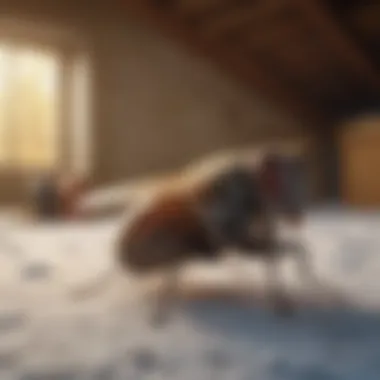

Intro
As winter sets in, many homeowners face a peculiar challenge—the emergence of attic flies in their homes. These pests can be more than just an annoyance; they signify underlying issues that require attention. Understanding the ecology of these flies and the factors that contribute to their presence in residential spaces is essential for effective management. This guide will explore various aspects of attic flies just as their name suggests, helping homeowners better grasp the reasons behind infestations and offering valuable strategies for prevention and control.
Understanding Pests
Definition of Pests
Pests are organisms that disrupt human activities, often causing damage to property and resources. In the context of residential environments, attic flies fall into this category due to their ability to breed and thrive in areas that are not typically monitored. These flies are usually more active during the winter months as they seek warmth and shelter. Identifying these pests correctly is crucial to addressing issues effectively.
Importance of Pest Identification
Recognizing attic flies precisely can pave the way for tailored treatment and prevention strategies.
"Incorrectly identifying pests can lead to ineffective control methods, wasting time and resources."
Attic flies can often be mistaken for other common insects. Proper identification helps in understanding their life cycle, behavior, and potential risks they pose to the home. This knowledge is fundamental to selecting appropriate strategies and interventions.
Prevention Techniques
Home and Garden Preventative Measures
Preventing attic fly infestations begins outside the home. Simple measures can significantly reduce the risk of infestation. Here are some strategies to consider:
- Seal Entry Points: Inspect your property for gaps and cracks, paying close attention to areas around vents, windows, and doors.
- Maintain Cleanliness: Regularly cleaning and decluttering attic spaces can deter pests from breeding.
- Proper Waste Disposal: Ensure that all trash is disposed of properly, as organic waste can attract flies.
Seasonal Prevention Tips
During the winter months, consider specific measures as temperatures drop:
- Insulate Attics: Proper insulation helps in maintaining temperature and discouraging pests.
- Monitor Humidity Levels: Flies prefer damp environments. Keeping humidity in check can make your home less inviting to them.
- Regular Inspections: Periodically checking attics and eaves for signs of flies or other pests will allow early intervention if needed.
Eco-Friendly Pest Control Solutions
Overview of Sustainable Practices
For homeowners who are environmentally conscious, embracing eco-friendly pest control methods is a priority. These methods aim to minimize environmental impact while effectively managing pest populations. Using natural solutions not only targets pests but also respects surrounding ecosystems.
Natural Remedies and Their Effectiveness
Several natural solutions have shown promise in controlling attic flies:
- Essential Oils: Oils like eucalyptus and peppermint can act effectively as repellents against attic flies.
- Diatomaceous Earth: This safe substance can be spread in affected areas, causing damage to the exoskeletons of pests without harming humans or pets.
Homeowners should research and test these remedies to see which ones yield the best results for their specific situation.
In summary, understanding why attic flies invade homes in winter and learning how to identify, prevent, and manage their presence equips homeowners with the tools necessary to maintain a comfortable dwelling.
Intro to Attic Flies
Understanding attic flies is crucial for homeowners, especially during the winter months. These pests often find their way into residential spaces, leading to potential discomfort and health risks. With the knowledge and insights offered in this section, you will become equipped to recognize the underlying causes of attic fly infestations. Not only will this help with identifying the specific species that may invade your home, but it will also provide foundational knowledge for effective prevention strategies.
Defining Attic Flies
Attic flies refer to various species of flies that typically inhabit the upper areas of homes, such as attics and lofts. They thrive in warm environments and seek shelter during colder months. These insects are often small, with characteristics that make them blend into their surroundings.
When discussing attic flies, it is essential to note their biological ties. Many species belong to the family Muscidae, which includes flies like house flies and cluster flies. Their presence indicates not only the potential for an infestation but also points to the health and structural integrity of the housing environment.
Common Species of Attic Flies
There are several notable species of attic flies that homeowners might encounter. Each species has different behaviors and needs, making them unique in their attraction to homes.
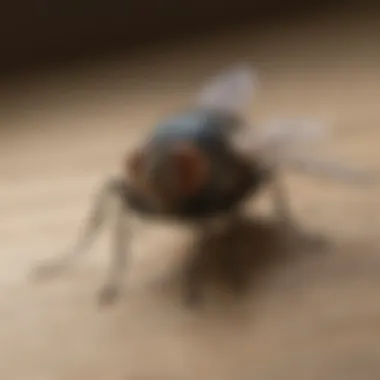
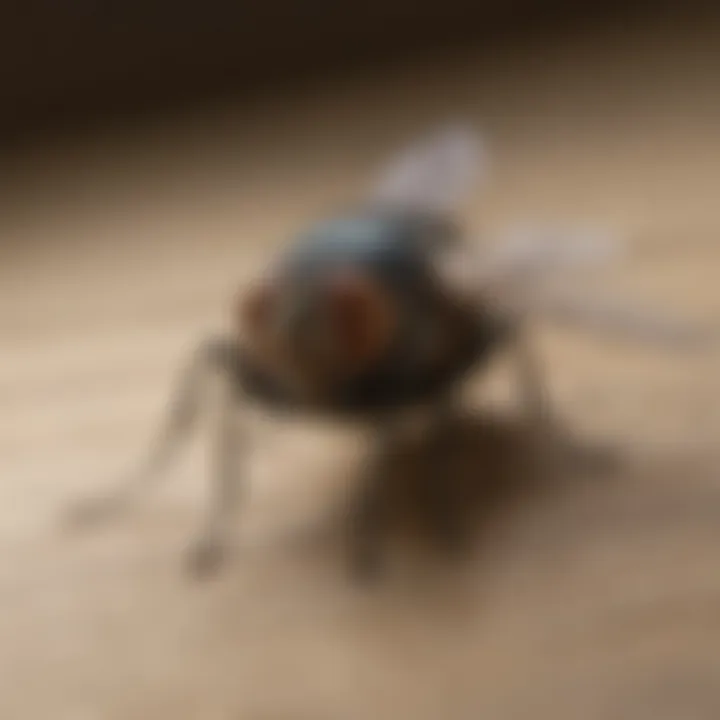
- Cluster Flies: Known for their sluggish movement, cluster flies often enter homes to escape the cold. They tend to gather in clusters, especially in sunny windows during winter.
- Flesh Flies: These flies are often found near decomposing matter. Their presence may indicate underlying sanitation issues in the home. They have a distinctive appearance, often dark gray with checkerboard patterns.
- House Flies: Common in many households, house flies can also migrate to attics in search of warmth and food. They reproduce rapidly, making control efforts essential.
- Moth Flies: Also known as drain flies, moth flies are small and fuzzy. They are frequently found near damp areas in attics. Their larvae thrive in organic debris, such as decomposing vegetation.
Each of these species requires different considerations for management, as their behaviors and preferred environments vary. Recognizing what you are dealing with is the first step in maintaining a fly-free home.
The Lifecycle of Attic Flies
Understanding the lifecycle of attic flies is crucial to addressing their presence in winter homes. This knowledge not only helps in recognizing signs of infestations but also aids in creating effective control measures. Each stage of the lifecycle presents specific opportunities for prevention and intervention. By comprehending the different phases of development, homeowners can proactively manage their environments and minimize the risks associated with these pests.
Egg Stage
The lifecycle of attic flies begins with the egg stage. During this phase, female flies can lay numerous eggs in optimal environments, often where food sources or suitable shelter exist. These eggs are generally small, typically ranging from 1-2 mm in length, making them hard to spot. It is common for flies to deposit their eggs in dark, damp areas like attics or basements, where conditions are favorable for hatching. The incubation period varies with temperature, usually taking a few days to a week. Homeowners may not notice these eggs until larvae begin to emerge, highlighting the need for regular inspections in potential breeding grounds.
Larval Stage
Once the eggs hatch, the next phase is the larval stage. Larvae, often referred to as maggots, are typically white and can range from 5 to 12 mm in length. This is a critical period for attic flies, as larvae feed on organic matter, decaying materials, and potential food sources found around the home. During this time, they are highly vulnerable, which presents an opportunity for control. Proper sanitation practices, such as removing food debris and sealing waste, can significantly disrupt their feeding cycle. Depending on environmental conditions, this stage can last from several weeks to months. In winter, colder temperatures can slow this process, allowing homeowners more time to correct issues before it escalates into a full infestation.
Adult Stage
The final phase is the adult stage, which reveals fully developed attic flies. At this point, these flies are fully capable of reproduction, continuing the cycle. Adult flies can often be seen buzzing around lights or windows, indicating their presence within the home. They tend to live for several weeks, during which time they mate and lay eggs. Identifying adult flies early is essential for managing any potential infestations. There are various methods for controlling adult fly populations, including traps and insecticides. It’s vital for homeowners to understand that controlling the adult population may not be sufficient if the eggs and larvae are not addressed.
Understanding the lifecycle of attic flies empowers homeowners to take strategic actions against infestations rather than relying solely on reactive measures.
Attraction Factors for Attic Flies
Understanding the attraction factors for attic flies is crucial for homeowners aiming to prevent infestations. Seasonal changes, especially in winter, lead to conditions that can make homes particularly appealing to these pests. A variety of factors contribute to this allure, including warmth and shelter, as well as food sources. Gaining insights into these elements can help in formulating effective strategies to control and prevent their presence.
Warmth and Shelter
Attic flies are often drawn to the warmth that residential structures provide during winter months. Homes maintain higher temperatures, creating an inviting environment, especially in areas like attics, basements, and walls where heat escapes more. Dark and cozy locations offer shelter, thus flies may filter in through small entry points such as gaps around windows, doors, or vents.
Homeowners should be aware of the potential for these pests to find refuge within their homes. Ensuring proper insulation can help regulate indoor temperatures and reduce the warm spots that may attract attic flies. Additionally, sealing any cracks or openings in the building envelope is vital. Not only does this limit entry points for flies, but it also adds benefits by improving energy efficiency.
Food Sources
In addition to warmth, food sources play a significant role in drawing attic flies into homes. Flies are scavengers and their diet consists of organic materials. This means that anything from decaying plant matter, stored food, to garbage can entice them. Improperly stored food in attics, or even pet food, can be particularly appealing.
To mitigate the risk of attracting flies, homeowners should maintain a high standard of cleanliness. Here are several important measures:
- Store food in airtight containers.
- Regularly dispose of garbage and compost.
- Clean up spills promptly.
- Check for any potential breeding grounds in attics, such as dead insects or old plants.
By understanding these attraction factors, homeowners can take proactive steps to minimize the risks associated with attic flies, thereby enhancing their living environment.
Identifying Attic Fly Infestations
Identifying attic fly infestations is a crucial step for homeowners in managing their living environment effectively. Being able to recognize signs of these pests can help mitigate problems before they escalate. Attic flies can proliferate quickly if left unchecked, leading to potential health issues and significant discomfort for inhabitants. Understanding the specific indicators of an infestation aids in early detection and can help avoid extensive treatment costs.
Signs of Infestation
Homeowners should be vigilant and attentive to any signs that may indicate an attic fly infestation. Here are some common indicators:
- Observation of Flies: One of the most obvious signs is the presence of adult flies in attics or near windows. These flies may be seen buzzing around lights or gathering in corners.
- Presence of Larvae: If small, maggot-like larvae are observed in dark corners or near food sources, it indicates that adult flies have laid eggs and that a population is developing.
- Decay or Spoilage: A smell reminiscent of decay can be an important clue. This odor often signals the presence of food sources that attract flies.
- Droppings: Small dark spots resembling pepper can be found where flies congregate. These droppings are a clear indicator of their presence.
- Health Issues: Any unexplained health concerns, such as skin irritation or allergic reactions, may stem from flies, thus highlighting the need to check for infestations.
Being aware of these signs increases the likelihood of intervening promptly, ensuring a healthier home environment.
Common Misidentifications
Homeowners often misidentify attic flies due to similarities with other insects, leading to confusion. It is essential to differentiate attic flies from similar pests to implement the correct management strategies. Here are some common misidentifications:
- Fruit Flies: Often mistaken for attic flies, fruit flies are smaller and usually found near fermenting materials. Unlike attic flies, they are attracted to fruits and vegetables rather than organic debris in attics.
- Cluster Flies: These flies are larger with a distinct golden color. They typically invade homes seeking warmth during the winter months but do not reproduce inside such environments as attic flies do.
- House Flies: Common in households, house flies are attracted to food waste and are larger than attic flies. Their typical habitats are kitchens rather than attics.
By correctly identifying attic flies, homeowners can take effective action. Utilizing local pest management resources can also provide targeted assistance in distinguishing and treating the specific type of infestation.
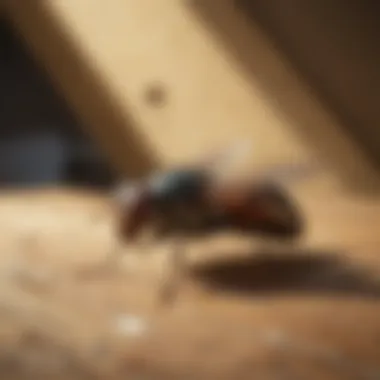
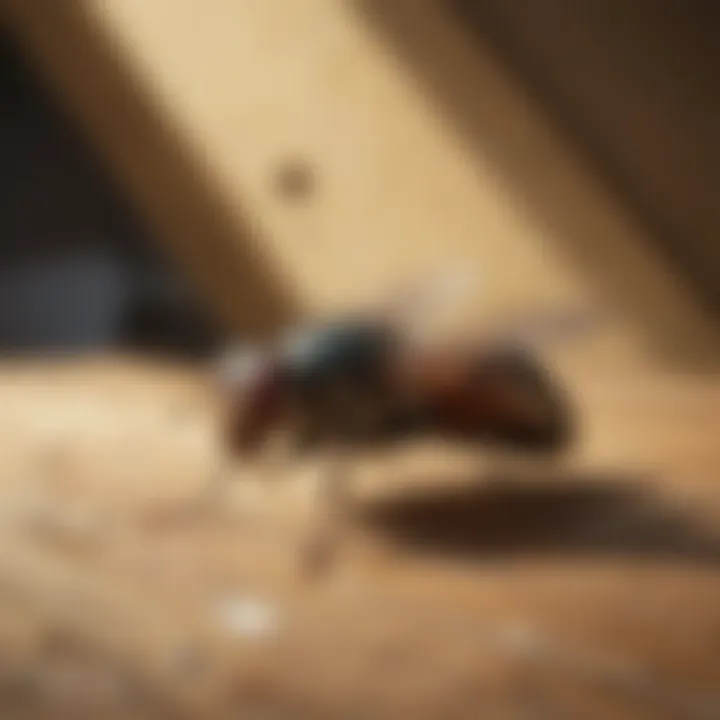
Health Risks Associated with Attic Flies
The presence of attic flies in winter homes can pose various health risks. Understanding these risks is crucial for homeowners to prevent complications that may arise from infestations. Attic flies, while often dismissed as mere nuisances, can carry pathogens and allergens that threaten the well-being of inhabitants. Thus, addressing these risks is not just about comfort but also about ensuring a healthy living environment.
Potential Diseases
Attic flies can transmit several diseases that could affect human health. One significant concern involves their ability to spread bacteria. Flies can pick up pathogens from waste, decaying materials, or even food, and then transfer these pathogens to surfaces where they land. Common sicknesses linked to flies include:
- Gastroenteritis: This condition stems from bacteria such as Salmonella that can be found in contaminated food.
- Food Poisoning: This arises when flies contaminate consumables, leading to symptoms like nausea, vomiting, and diarrhea.
- Respiratory Infections: Flies may carry viruses that impact respiratory health, especially in vulnerable populations.
Maintaining awareness of these diseases is essential for homeowners, as it serves as a compelling reason to manage attic fly populations effectively.
Allergic Reactions
Another critical health concern related to attic flies is the potential for allergic reactions. Many individuals are sensitive to fly droppings, body fragments, and saliva. Exposure to these allergens can bring forth several symptoms, including:
- Sneezing and nasal congestion
- Itchy, watery eyes
- Skin rashes
In severe cases, allergic reactions may lead to asthma attacks or other respiratory issues. For households with young children or elderly members, the risk is heightened. This emphasizes the need for thorough cleaning and prompt action when signs of an infestation are detected.
"Regular monitoring and proactive measures can mitigate the health risks posed by attic flies, ensuring a healthier living space for you and your family."
Winter Conditions and Their Impact
Understanding the impact of winter conditions on attic flies is vital for homeowners seeking to manage these pest intrusions effectively. As temperatures drop, many insects enter a state of dormancy or change their behavior to survive. This section delves into the specific adaptive strategies that attic flies employ during the cold months, as well as notable shifts in their patterns. Recognizing these nuances can help in crafting effective prevention and control measures.
Survival Tactics of Flies in Cold
During the winter months, attic flies employ various survival tactics to endure harsh conditions. One primary strategy involves seeking warm shelter, which is why attics become a prime target. Flies can often be found clustering together in secluded areas, taking advantage of any heat generated from household systems or insulation materials.
Flies have demonstrated a capacity to enter a state of dormancy, known as diapause, where their metabolic activity slows down significantly. This enables them to withstand cold temperatures for extended periods. Interestingly, some species might even seek out moisture during winter, as humidity can be higher in certain areas of an attic. This balance of warmth and moisture helps maintain their survival. Additionally, it's important to know that when warmer days appear, the flies may become active, possibly leading to unexpected infestations.
- Flies congregate in warm spots within attics.
- Diapause allows them to survive cold spells.
- Moisture can attract flies during winter.
Seasonal Behavior Changes
As winter progresses, the behavior of attic flies shifts significantly. The cold affects not only their physical activity but also their reproductive patterns. Under cold conditions, mating typically slows, reducing the likelihood of rapid population growth during this time. However, when temperatures rise, their behavior becomes more active. Adult flies, especially, might emerge from their dormancy, leading to swarms if left unchecked.
In many instances, attics that appear calm during the winter can suddenly become noisy and buzzing with flies at the onset of spring. Homeowners might notice this increased activity, which often corresponds to warmer temperatures. Awareness of these seasonal changes helps in scheduling inspections and preventive measures precisely.
"For homeowners, understanding the seasonal behavior of attic flies is critical for effective pest management."
In summary, winter conditions profoundly impact the survival tactics and behavior changes of attic flies. Recognizing their dormancy patterns and understanding spikes in their activity can inform strategic measures for prevention. This knowledge also enhances the long-term management of these pests, allowing for interventions to be more timely and efficient.
Prevention Strategies for Homeowners
Understanding the presence of attic flies during cold months underscores the need for effective prevention strategies. Homeowners facing these nuisances must realize that proactive measures can significantly mitigate the chances of infestation. Implementing preventive efforts is often more efficient and environmentally responsible than dealing with an established population of flies.
The significance of prevention lies in its dual role: first, it minimizes health risks tied to attic flies, and second, it reduces the financial burden associated with pest control treatments. Effective strategies allow homeowners to safeguard their living spaces without relying solely on chemical solutions, thus preserving home hygiene and comfort.
Seal Entry Points
One of the most crucial aspects of preventing attic fly infestations is sealing entry points. Flies can access properties through small openings, cracks, or gaps around windows, doors, vents, and even the roofline. Addressing these vulnerable areas can thwart their entrance into homes.
- Inspect Regularly: Start by conducting a thorough inspection. Check for gaps around windows and doors and look for cracks in the foundation or siding.
- Use Appropriate Materials: Apply weatherstripping to doors and windows. Utilize caulk or expanding foam to seal larger gaps.
- Roof Maintenance: Ensure that your roof is in good condition. Missing shingles or deterioration can create spaces where flies might enter.
"Sealing entry points is a fundamental step that all homeowners should prioritize to prevent unwanted intrusions."
By focusing on these sealing efforts, you can create an environment that is less inviting to attic flies, subsequently decreasing the chances they will take up residence.
Maintain Cleanliness
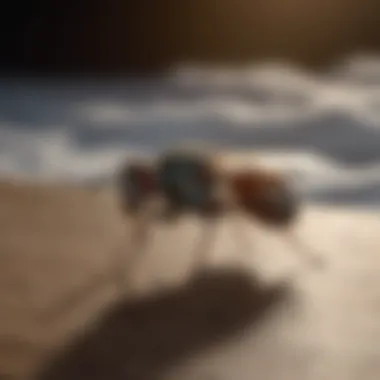

Maintaining cleanliness in the home is another vital prevention strategy. Flies are often attracted to dirt and debris, which can serve as food sources or breeding grounds. Keeping areas free of clutter and food remnants can significantly decrease their attraction to your home.
- Regular Cleaning: Implement a routine cleaning schedule in attics, basements, and other seldom-used spaces. Dust and vacuum these areas to remove potential nesting materials.
- Manage Food Waste: Dispose of food scraps promptly and use sealed containers for trash.
- Outdoor Cleanliness: Ensure that outdoor spaces, like porches or patios, are tidy. Sloppy outdoor maintenance can attract flies, leading them to seek entry into your home.
In summary, a clean home is a less appealing target for attic flies. By keeping spaces organized and well-maintained, you can effectively reduce the likelihood of an infestation.
Control Measures for Attic Flies
Control measures for attic flies are integral to maintaining a healthy and comfortable environment in winter homes. As these insects may pose health risks and lead to unsightly infestations, understanding effective strategies becomes essential for homeowners. The approach to managing attic flies involves both chemical and non-chemical methods.
Using a combination of control measures helps ensure that not only are the existing flies addressed, but that future infestations are also prevented. This duality is crucial given how quickly the presence of these flies can escalate, especially in sheltered indoor locations during cold months.
Chemical Control Options
Chemical control options can be effective in reducing and eliminating attic fly populations. These methods generally involve the use of insecticides, which are particularly beneficial when infestations become severe. Various products are formulated specifically to target flies, employing active ingredients designed to disrupt their lifecycle or to exterminate them upon contact.
Important Considerations:
- Opt for products that are labeled for indoor use to ensure safety.
- Follow the manufacturer instructions closely to avoid over-application, which can be harmful.
- Look for formulations that have low toxicity to humans and pets, as these will mitigate risks associated with chemical exposure.
Some common options include aerosol sprays that can easily reach hard-to-access areas like attics. A few treatments in conjunction with other preventive measures can enhance the effectiveness of the approach.
Non-Chemical Methods
Non-chemical methods often provide a safer alternative for managing attic flies. These approaches focus on creating an environment that is less conducive to fly habitation and reproduction.
Strategies Include:
- Traps: Using sticky traps can provide a simple means to catch flies without chemicals. These traps can be placed in various locations within the attic.
- Exclusion Techniques: Sealing potential entry points significantly reduces the chances of flies entering. Employing caulk and other sealants around vents, gaps, or cracks prevents access.
- Routine Cleaning: Keeping the attic clean helps minimize food sources, thus reducing attraction. Regular inspections and prompt removal of organic materials and debris can be quite effective.
- Environmental Controls: Adjusting the attic's climate can also deter flies. This might involve increasing ventilation or reducing humidity levels.
In summary, successful control measures for attic flies hinge upon a thoughtful combination of chemical and non-chemical methods. It is essential to remain proactive and vigilant in monitoring the situation to keep your home free from these unwelcome guests.
Long-term Management Strategies
Long-term management strategies for attic flies are essential to ensure that infestations do not recur year after year. Homeowners often feel overwhelmed when dealing with pest issues, especially in the confined spaces of attics. Understanding and implementing effective management approaches can significantly reduce the anxiety associated with such infestations. These strategies will help maintain a pest-free environment while minimizing the impact on the local ecosystem.
Monitoring and Inspection
An ongoing monitoring and inspection program is vital for preventing attic fly infestations. Homeowners should regularly check their attics for signs of flies or their larvae. This proactive approach helps in identifying infestations early.
- Routine Checks: Schedule bi-monthly inspections during the winter months when attic flies are most active. Look for:
- Use of Traps: Sticky traps can be useful in determining the population levels of attic flies. Place them in strategic locations to monitor activity and understand peak moments of infestation.
- Record Keeping: Maintain a log of inspections, noting down findings to recognize patterns over time. This helps in making informed decisions regarding pest control methods.
- Professional Inspections: Consider hiring pest control professionals for a comprehensive assessment. They have specialized training to identify susceptible areas in your home.
- Adult flies resting on beams or walls.
- Larvae in dark corners or near potential food sources.
Regular monitoring can catch problems before they escalate, hence saving on costly remediation efforts.
Integrated Pest Management Approaches
Integrated Pest Management (IPM) is a comprehensive strategy that combines various control methods and practices to manage attic flies effectively. This approach does not merely focus on extermination but emphasizes the prevention of future infestations while considering environmental impacts.
- Biological Control: Explore the potential of introducing natural predators of attic flies, like certain species of spiders or birds, which can help in reducing their populations naturally.
- Habitat Modification: Make adjustments in your attic to discourage fly presence. This could include sealing gaps, ensuring proper ventilation, and reducing humidity levels.
- Cultural Practices: Maintain cleanliness and remove food sources that may attract flies. Regularly clean the attic, removing old boxes, debris, and any deceased insects that may serve as food sources.
- Chemical Options: Use pesticides only as a last resort and opt for products that are less harmful to the environment, ensuring that they are applied according to label directions to minimize risks.
Each of these strategies contributes to a holistic approach in managing attic fly issues, balancing effective control with environmental responsibility. By implementing a strong IPM framework, homeowners can significantly lower the chances of future infestations, providing peace of mind for seasons to come.
Closure
Addressing the presence of attic flies during the winter months is vital for homeowners. This article emphasizes understanding their behavior, lifecycle, and attraction factors in the context of residential environments. By recognizing these elements, homeowners can effectively combat potential infestations and reduce risks to health and property.
Summary of Key Points
In summary, the article has covered several critical areas related to attic flies in winter homes. Key points include:
- Understanding the biology and lifecycle of attic flies is essential for effective management.
- Identifying signs of infestation can prevent larger issues. This includes recognizing common misidentifications.
- Attraction factors such as warmth and food sources that draw attic flies into homes have been detailed.
- Prevention strategies discussed include sealing entry points and maintaining cleanliness, which are crucial in avoiding infestations.
- Control measures provide a mix of chemical and non-chemical solutions.
- Long-term management approaches ensure that homeowners can sustain a fly-free environment effectively.
Future Considerations
Looking ahead, ongoing research into the behaviors of attic flies will help in developing more targeted management strategies. Homeowners should stay informed on updates in pest management practices. Environmental considerations remain crucial; thus, balancing effective control with ecological responsibility should be a focus.
Moreover, as climate change continues to influence insect behavior, adaptations in how attic flies acclimatize to residential settings may become more prevalent. Homeowners need to adopt adaptable strategies that respond to these changes. Regular monitoring and inspections will play a key role in sustaining their homes against future attic fly populations.



